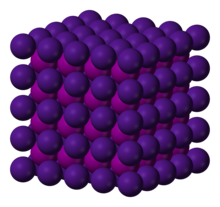Caesium iodide

| |
| Names | |
|---|---|
| IUPAC name
Caesium iodide
| |
| Identifiers | |
3D model (JSmol)
|
|
| ChemSpider | |
| ECHA InfoCard | 100.029.223 |
CompTox Dashboard (EPA)
|
|
| |
| |
| Properties | |
| CsI | |
| Molar mass | 259.81 g/mol |
| Appearance | white crystalline solid |
| Density | 4.51 g/cm3, solid |
| Melting point | 621 °C |
| Boiling point | 1277±5 °C |
| 44 g/100 ml (0 °C) | |
Refractive index (nD)
|
1.739 |
| Structure | |
| CsCl | |
| Pm3m, No. 221 | |
a = 456.67 pm
| |
| Cubic (Cs+) Cubic (I−) | |
| Hazards | |
| Flash point | non-flammable |
| Related compounds | |
Other anions
|
Caesium fluoride Caesium chloride Caesium bromide |
Other cations
|
Lithium iodide Sodium iodide Potassium iodide Rubidium iodide |
Except where otherwise noted, data are given for materials in their standard state (at 25 °C [77 °F], 100 kPa).
| |
Caesium iodide (American English: Cesium iodide) (CsI) is an ionic compound often used as the input phosphor of an x-ray image intensifier tube found in fluoroscopy equipment.
An important application of caesium iodide crystals, which are scintillators, is electromagnetic calorimetry in experimental particle physics. Pure CsI is a fast and dense scintillating material with relatively high light yield. It shows two main emission components. One in the near ultraviolet region at the wavelength of 310 nm and one at 460 nm. The drawbacks of CsI are a high temperature gradient and a slight hygroscopicity.
Caesium iodide can be used in Fourier Transform Infrared (FT-IR) spectrometers as a beamsplitter. CsI has a wider transmission range than the more common potassium bromide beamsplitters, extending usefulness into the far infrared. A problem with optical-quality CsI crystals is that they are very soft with no cleavage, making it difficult to create a flat polished surface. Also, the CsI optical crystals must be stored in a desiccator to prevent water damage to the surfaces, and coated (typically with germanium) to minimise water damage from short term atmospheric exposure during beamsplitter swapouts.
Optical properties
- Transmission range: 250 nm to 55 µm
- Refractive index: 1.739 at 10.6 µm
- Reflection loss: 13.6% @ 10.6 µm (2 surfaces)
Physical properties
- Hardness (Knoop): 137.9 kPa (20 lbf/in2)
- Young's modulus: 5.3 GPa (769 lbf/in2)
- Modulus of rupture: 5.6 GPa (810 lbf/in2)
- Apparent elastic limit: 5.6 GPa (810 lbf/in2)
- Structure: Cubic, no cleavage
- color: colorless
References
